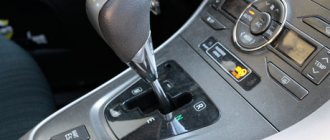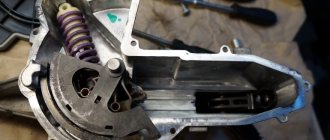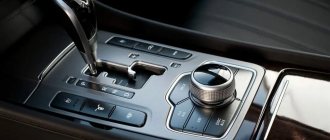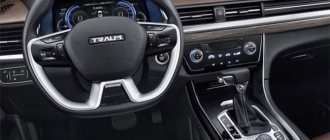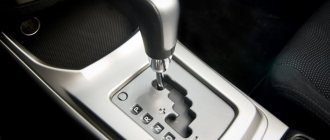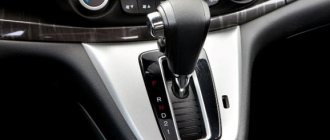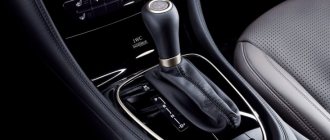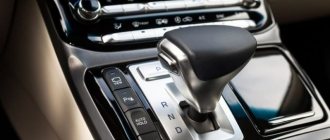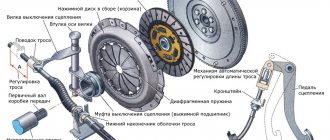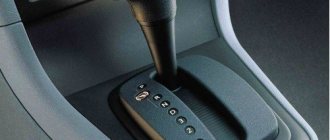Passenger cars use several types of stepped transmissions that provide manual or automatic gear shifting. On some cars there is a robotic gearbox, created on the basis of a mechanical one, but with automatic gear shifting and clutch control. The driver needs to know how to drive a robot, since the life of the clutch and the mechanical part of the gearbox depends on proper operation.
Robotic gearboxes are quite popular these days.
A little about the device
The essence of such a box is quite simple - there is a manual gearbox and an electronic control unit for it. With a manual transmission, all the functions that a driver with a manual transmission had to perform (squeezing the clutch, moving the gearbox lever to the desired position) are performed by actuators - servos of the electronic unit.
Thanks to this, the reliability of the gearbox has increased due to the use of classical “mechanics” and the ease of use has increased. The driver just needs to move the selector to the desired position (as in an automatic transmission) and enjoy the ride, and the electronic unit will take care of the gear shift.
With all this, many robotic boxes are also equipped with manual controls, which allows the driver to control the box independently, with the only difference - there is no need to squeeze the clutch.
Control Features
The manual transmission received some operating modes from the automatic transmission, namely:
- "N" - neutral. A mode in which torque is not transmitted to the wheels from the gearbox. That is, the engine is running, rotation is transmitted to the box, but due to the position of the gears, it is not transmitted to the wheels. Used when parking a car for a long time, before starting to move, after stopping;
- "R" - reverse movement. Everything is simple here, the driver moves the selector to this position and the car moves backwards.
Other modes of the robotic box have their own designation:
- "A/M" or "E/M" - forward movement. This mode corresponds to the “D” mode of an automatic transmission, that is, the car moves forward and the gearbox changes gears. In “M” mode manual control is performed. By moving the selector to a certain groove, the required mode is selected;
- “+”, “-” - gear switch. Short-term shifts of the selector to the “+” or “-” side ensure gear shifting in the “M” manual control mode.
Variable speed drive
The variator is characterized by smooth operation - there are no gears, and the torque is transmitted through a belt sliding along the cones and changing the ratio of their revolutions. The service life of variators is comparable to the service life of hydromechanical automatic machines. But CVTs do not like off-road conditions and slipping, they overheat and fail faster. Moreover, in the city such a gearbox is indispensable precisely because of the smooth operation due to the lack of switching.
| Pros: | Minuses: |
|
|
Is it necessary to warm up the box?
It seems that everything is simple, and there is nothing complicated in controlling such a box - just move the selector to the desired position and start moving. Still, you should know how to control the robot box so that it works without problems.
Let's start with an interesting question - is it necessary to warm up the gearbox before driving in winter? For an automatic transmission in winter, warming up is mandatory and is performed by briefly moving the selector to all positions.
The robotic gearbox is essentially mechanical and does not require warming up. And yet, in winter, the manual transmission should be warmed up before driving, although this is not exactly warming up. When parked, the oil in the box flows down and thickens due to frost. Therefore, it is recommended in winter, after starting the engine, to give time so that the oil does not warm up, but simply spreads over the elements of the box, reducing friction between them. It’s enough to just stand for a couple of minutes with the engine running, and you don’t need to switch the selector to different modes, just keep it in the “N” position. After this, you need to start moving smoothly, without sudden jerks, and drive for at least 1 km, which will ensure complete heating of the oil.
Do you need to warm up your car in winter?
How to control a robotic gearbox? First you need to decide whether there is a need to warm up the box before using it in winter. If you use an automatic device, then you know that in cold weather you cannot do without pre-warming, which is done by briefly moving the selector to all existing positions.
Driving a car with a robotic gearbox does not require additional manipulations, even if the temperature outside is sub-zero. However, in winter the gearbox should still be prepared for upcoming use. The fact is that while the car is standing, the oil inside the device flows down and, due to low temperatures, its consistency changes: the substance becomes much thicker.
For this reason, in the cold season, it is recommended to start the engine and wait some time for the oil to warm up and distribute throughout all the elements that make up the box. This will reduce friction and reduce wear on parts in contact with each other. For the process to be successful, you need to wait two minutes and start the engine.
Then you can smoothly, trying not to make sudden jerks, move for a kilometer, which will contribute to optimal heating of the oil fluid.
Starting the climb, overcoming it, descending
Many cars with manual transmission are not equipped with a hill start assist system, so the driver himself needs to learn how to start driving correctly. When starting uphill, you must proceed with the robotic gearbox in the same way as with the “mechanics”. To start driving, the selector is switched to mode “A”, the accelerator is smoothly pressed and at the same time the car is removed from the handbrake. This action will prevent the car from rolling back. You should practice pressing the gas and releasing the handbrake at the same time so that the driver can feel the engine and understand when the clutch has started to engage and can be released from the handbrake.
When starting to climb in winter, it is better to use manual mode and set the car to first gear. It is not worth accelerating too much to avoid wheel slipping.
When driving uphill with the automatic mode selected, the box will begin to shift to lower gears on its own, which is quite logical, because at higher speeds it is easier to overcome the climb. This gearbox is equipped with a gyroscope that determines the position of the car, and if the sensor shows a rise, the box will work accordingly. You can also move in manual mode by locking in a specific gear. It is important to understand that the manual transmission will not allow you to move under tension, so when climbing, the engine speed should be at least 2500 rpm.
When descending, no action is required from the driver. It is enough to move the selector to position “A” and remove the handbrake. In this case, the car will perform engine braking.
Robotic gearbox device
The robotic gearbox is a mechanical step transmission complemented by an electronic control unit. The clutch is controlled and gears are switched by actuator servo drives (electric or hydraulic). To start driving, the driver must place the selector lever in position A (move forward) or R (move backward), and then release the brake pedal.
The control unit switches speeds depending on the crankshaft speed and movement resistance. The design of the controller includes a special sensor that records the angle of inclination of the vehicle. Depending on the position of the car, the operation of the robotic box is adjusted.
The design of the box provides a manual shift mode, designated by the letter M. To select the speed, you need to press the selector forward or backward, up or down the gear. The electronic controller monitors the engine operating mode and driving speed; the permissible ratios of speeds and revolutions of the power unit are stored in the device’s memory. For example, the block will not allow an attempt to start from 3rd gear or twist the engine crankshaft by mistakenly engaging a lower gear ratio when driving on the highway.
Servicing a robotic gearbox involves conducting computer diagnostics to determine the residual thickness of the clutch friction linings. If you handle the transmission carelessly, accelerated wear of the clutch linings occurs. Changing dimensional chains negatively affects the operation of actuators that are calibrated in the factory.
When carrying out annual vehicle maintenance or every 10-15 thousand km, the design is adapted to compensate for the wear of the linings. Neglecting the adaptation procedure leads to incorrect operation of the unit and its transition to emergency mode. In the mechanical part of the transmission, the oil is replaced with a fluid recommended by the manufacturer. The frequency of unit maintenance depends on the manufacturer; recommendations are given in the vehicle’s service book.
The robotic gearbox selects and engages the required gear without driver intervention.
Stop, parking
And the third important issue is the correctness of parking and stopping. After the car has come to a complete stop, the selector must be moved to neutral “N”, put on the handbrake and then turn off the engine. During short stops, moving the selector to neutral is not necessary; it is quite possible to remain in mode “A”. But it is worth considering that when stopping, the clutch remains depressed. Therefore, in a traffic jam or at traffic lights, when the stop takes longer, you should still switch to neutral.
Other modes
These are the basic rules on how to operate a robotic box. But there are other features, for example, some manual transmissions have additional modes - sport and winter, the so-called “snowflake”.
“Snowflake” is aimed at starting movement on an icy road as smoothly and without slipping as possible. All it does is ensure that the car starts straight from second gear and makes upshifts smoother.
The “sport” mode switches to higher gears at higher speeds than in normal mode. This allows you to accelerate faster. That is, if in normal mode the transition to 2nd gear was performed, for example, at 2500 rpm, then in the “sport” mode this transition will be carried out at 3000 rpm.
Now about the possibility of switching from automatic to manual mode and back while driving. The robotic box allows you to do this without any problems. It is also possible to independently downshift or upshift to change the speed of movement. But it is worth considering that the electronic unit will not completely transfer control of the box; it will constantly monitor the operation.
How to drive Isitronic correctly?
Pulling away In order to bring a car with electronics
into action, you need to hold down the main brake pedal and switch the gearbox to automatic mode. At this moment, the “A” signal is highlighted on the monitor, and first gear (A1) is engaged.
Interesting materials:
Why doesn't brightness adjustment work on my laptop? Why doesn't safari work? Why doesn't the SD rom work? Why doesn't the sensor work on iPhone 5s? Why doesn't the sensor on my tablet work? Why doesn't shift work on a laptop? Why doesn't the alligator alarm work? Why doesn't the Starline alarm work? Why doesn't the SIM card work on Meiza? Why doesn't synchronization work?
Useful tips
Finally, some recommendations for the operation and maintenance of the robotic box.
This gearbox does not tolerate sudden pressure on the gas pedal, so it is better to drive in a quiet mode. Even if you need to speed up, it’s better to press the accelerator smoothly, while switching to manual mode. And when braking, you should do the opposite - switch to automatic mode.
A feature of manual transmission is the presence of small shocks when changing gears. You can get rid of them quite simply - when changing gears, reduce the engine speed, that is, act by analogy with a conventional manual transmission.
The presence of a manual mode even allows you to perform a “rocking” exit if the car gets stuck in a snowdrift. But at the same time, this will not benefit the gearbox, since slipping on a manual transmission is not recommended, this can lead to decalibration of the actuators. Therefore, it is still better to remove a stuck car with outside help.
During each maintenance, it is necessary to initialize and diagnose the condition of the manual transmission, which will allow you to eliminate all faults of the box at an early stage.
There are other small features of such boxes that depend on the manufacturer. It is better to inquire about them immediately, so that in the future there are no misunderstandings with the operation of the robotic box.
The development of the automotive industry does not stand still. People are trying to improve their lives, make it more comfortable and convenient. Car manufacturers are trying to make driving as easy as possible for their customers. Due to this, various technologies are constantly being improved. Thus, an automatic clutch was attached to the manual transmission. By putting these two elements together, the developers received a so-called robotic transmission, combining all the advantages and disadvantages of the units. People also know the name “robot box”.
How to learn to drive with a robotic gearbox? Main control features
To prevent transmission malfunctions, you need to know how to use the robot, namely:
- how to warm up the unit;
- how to start movements correctly;
- how to use the transmission when operating a car in city mode.
Warming up the robotic gearbox and operating features
Many car manufacturers claim that robotic units do not need to warm up. But in this matter, it is necessary to take into account the temperature of the working fluid in the lubrication system, as well as how the oil behaves in frosty conditions. Some types of consumables thicken at low temperatures and accumulate at the bottom of the unit. According to the standard, the warm-up process consists of starting the engine and waiting 2-3 minutes. When warming up the car, you do not need to touch the gearshift lever.
If the car is in a garage, then you need to drive it out calmly and smoothly to avoid jolts and jerks. When warming up, you need to monitor the number of revolutions; ideally, their number will be minimal and will be about 1 thousand per minute. The unit should also be warmed up in the summer, thanks to this all the components of the robot will be properly lubricated. Warming up will prevent rapid wear and tear of the unit components.
Main operating features that will increase the operating life of the unit as a whole:
- Avoid slipping when driving in cold weather. This will lead to rapid wear of the actuators and components. Regular slipping will cause the unit to miscalibrate.
- Experts do not recommend frequent driving on heavily snow-covered surfaces. The vehicle may get stuck, which will ultimately cause slippage.
- It is recommended to use products equipped with studs as winter tires. When installing regular tires on wheels, there is a risk of slipping on ice.
- During long downtimes of several days or more, it is recommended to set the gearbox selector to position E. The engine must be turned off.
- If the road condition is poor, experts advise starting to drive in second gear, but not accelerating too much.
Alexey Rykov spoke about the basic principles of controlling a robotic gearbox using the example of the Lada Granta.
Rules for the correct start on a robot box
Owners of cars equipped with robotic gearboxes should take into account that some vehicles do not have the additional option of starting assistance. In particular, we are talking about starting to move on a hill, uphill
Therefore, it is important to learn how to get started correctly. The starting procedure is carried out in the same way as on a car with a mechanical unit
More information about getting started:
- The parking brake lever must be raised.
- The gear lever is set to mode A.
- The driver easily, effortlessly presses the gas.
- At the same time, the parking brake lever is released.
If, when you start driving outside, there is sub-zero temperature and high humidity, the box selector can be moved to position M1. The force on the gas pedal must be acceptable so that overslip does not occur. If the machine is equipped with a gyroscope, then when selecting the automatic mode, the microprocessor of the unit itself will select the required speed and switch. This will allow you to switch speeds down. If the driver is experienced, then, taking into account the situation, he can set the M mode when fixing the set gear.
If the speed limit is initially set, then it is not recommended to change the speed of movement. The engine speed should be between 2500 and 5000 per minute, but not beyond this range. When you start driving downhill, the transmission selector is set to mode A and the handbrake lever is released.
Operation of a robotic gearbox in urban environments
Regular use of the vehicle in city traffic and traffic jams can lead to rapid wear of transmission components. To prevent this, when stopping the car, you should move the gear lever to mode N. Then the parking brake is activated and the engine is stopped. If the stops are short-term, for example, in traffic jams, then the neutral mode does not need to be turned on; it is enough to stop when the lever is set to mode A. If the car sits in a traffic jam for more than one minute, then the engine will need to be stopped.
Vasily Kostin spoke about the intricacies of using machines with an installed robot.
Gearbox device
When clarifying the features of such a design, you need to pay attention to the relevant reviews. The robot box requires specific handling, but in order to understand why, you will need to understand its structure.
Based on the preliminary description, one might think that the overall design is a simple machine with special controls. However, it is not. Let's consider this issue in more detail.
The design is based on a manual transmission, which, according to reviews from both professionals and ordinary drivers, is considered more reliable than an automatic one. This can be understood by reading reviews on the Internet. The robot box has special devices. They are necessary in order to depress the clutch when changing gears.
It is worth noting that when using a conventional manual transmission, the driver independently chooses the shift time. To do this, he focuses on what is happening on the road and uses the clutch pedal in conjunction with the transmission lever itself. When developing a new device, which received controversial reviews from drivers, the robot box showed itself from a completely different side. It was decided to exclude the direct actions of the driver from the above process. All important switching is carried out by the computer. For the successful functioning of the robot, special actuator units were installed. Thanks to them, gear shifting, controlled by the computer itself, became possible.
Judging by the reviews, consumers note several main advantages. We are talking about huge fuel savings and ease of repair. Also, some consumers like the absence of a clutch pedal. Another advantage highlighted by drivers is that it is possible to manually change gear.
The structure of the robot box and how to use it
A robotic gearbox is a manual transmission with a robotic or automated dual-clutch system that has a double set of gear shifters. One is for odd gears and the other is for even gears. In addition, it has an electronic calculator that determines the best time to change gear and synchronizes various operations. The driver can also switch to manual mode. This mode allows you to change gears at your discretion, although there is no clutch pedal.
How does a robot differ from a machine gun?
It is important to understand how the automatic transmission functions. When the first clutch automatically engages first gear, the second clutch engages the next gear and so on. This makes the car behave as if it had an automatic transmission.
With a robotic gearbox, shifting comfort is lost. This is a significant disadvantage of the transmission compared to automatic transmission. A slight jerk is felt when changing gears.
Advantages and disadvantages
The robotic gearbox attempts to combine the best of both types of transmissions. Its technology is the same as that of a manual transmission, so consumption is reduced and manual controls are automated to try to match the convenience of automatic shifts.
This transmission has advantages and disadvantages. In the first case, you can find that it has a lower cost than an automatic transmission and performs the same function. A robotic gearbox does not increase fuel consumption like automatic transmissions. The advantages in this case are obvious.
How to control a robotic gearbox to save clutch
A robotic gearbox is the best solution for those who are looking for a comfortable driving style, forgetting about the clutch.
In practice, cars equipped with robotic gearboxes are easy to drive and allow you to “relax” a little. In addition, on sports cars, manual transmission speeds up gear changes and eliminates the risk of errors that lead to transmission failure.
Wet and dry
There are two versions of this gearbox with a “wet” and “dry” clutch.
| Wet clutch | Dry clutch |
| The box components are in an oil environment. Due to this, cooling occurs, friction between working surfaces is reduced and wear of parts is reduced. Vehicles with high torque have this type of clutch. | It functions “dry”, so it is much inferior to its “wet” counterpart. But such a clutch is quite simple and reliable due to the absence of an oil pump. |
What can break in a robot?
One of the most common breakdowns is associated with a worn gear selector fork. As a result of such a breakdown, it is not possible to engage the desired gear. Also, breakdowns are often associated with rolling bearings, which make noisy sounds and need to be replaced. Failures of electronic equipment are also possible.
Symptoms of a problem
A frightening, but fairly harmless symptom of a breakdown is problems with the “brains” of the gearbox. The selector position is no longer recognized or it is impossible to change gears, and sometimes even turn on the engine.
Another malfunction is the failure of the switching drives. The teeth on the gears are chipped, the levers dangle by themselves.
Main external signs of malfunctions:
- when moving, audible noises are heard;
- the alarm indicator lights up;
- clutch slips;
- there is no standard reaction when the engine speed increases (the speed does not increase);
- liquid is leaking from the box;
- when moving slowly, strong jerks are felt when shifting;
- The transmission stops working and the car stops.
How does it work?
The box in question operates using actuator units, which we have already discussed earlier. They collect information about such details as driving speed, power unit speed, and the operation of some sensors. Based on the received data, the computer makes a decision about which transmission needs to be activated. As far as drivers know, the servo is responsible for the clutch. It is he who receives the command to change the mode and disconnects the engine from the input shaft. During this process, the second servo is activated, it selects the gear that is needed and instantly turns it on. After a second, the engine is reconnected to the shaft, and the car continues on its way. This whole process happens as quickly as possible, so the person doesn’t even notice. All he can notice is a small impulse, but nothing more. This is exactly how this “robot” gearbox works. We'll look at the reviews below.
Servo drives come in two types. There are electric and hydraulic. The first is a motor that is capable, using a gearbox, of moving the executive part. The hydraulic one operates through a special cylinder. It receives commands directly from the control unit.
Transmission Benefits
During use, drivers identify existing disadvantages and advantages. Of course, we need to talk about them too. What statements can you come across when researching reviews? The robot box has its own characteristics. Let's first look at the benefits.
- Consumers note that, unlike an automatic transmission and a CVT, a robotic gearbox is reliable and more convenient.
- Almost all models of the described transmission are capable of operating in manual mode, in which the driver can change gears himself.
- Many buyers notice that the robot box (positive reviews predominate) has a much smaller working volume. Accordingly, a small amount of oil is needed.
- If you put cars with different transmissions in the same driving conditions, then the consumption of the robotic one is much less than that of others.
- The clutch of the described gearbox has a 30% higher service life.
- Consumers have noticed that the maintenance and repair work of such a transmission is much cheaper.
- The weight of a robotic gearbox is not as heavy as that of an automatic one. Due to this, it is easier to install it on a small car.
Typical faults
You can often hear that robotic gearboxes are extremely unreliable. The first models of such units actually failed quite often, but newer models are slightly inferior to traditional manual and automatic transmissions in survivability and performance. The fact that they are becoming increasingly popular in the automotive industry also speaks in favor of robot boxes However, their characteristic malfunctions are worth talking about. The main symptoms of malfunctions include:
- Clutch slipping;
- Too slow response to increasing engine speed;
- The appearance of sound noise (knocking, buzzing or howling);
- Operation of the indicator light on the dashboard;
- Jerks when automatically shifting gears during smooth movement;
- Leaking transmission fluid;
- Complete failure of the transmission.
As the reader already knows, automatic transmissions are essentially modified “ mechanics ”, which means they are characterized by the same malfunctions as conventional manual transmissions. In particular:
- Worn speed selector fork;
- Wear of rolling bearings.
Electrical components of the manual transmission can also fail. Despite the fact that almost all electrics in robotic units have a long service life, breakdowns are not uncommon. Especially when it comes to manual transmission of obsolete models . The following malfunctions can be noted:
- Burnout of contacts of electric drives;
- Damage to wiring;
- Failure of sensors;
- Burnout of contact groups;
- Control unit malfunction.
As a rule, electrical equipment fails due to overheating. It is important for a car enthusiast to monitor the performance of the cooling system. For example, the system channels may become clogged - this will lead to obstructed coolant flow with subsequent overheating of individual manual transmission elements. It is also worth monitoring the condition of the oil . Not only does it prevent dry friction, but it also absorbs and removes excess heat.
Disadvantages of the gearbox
Even with such a list of advantages, the device also has its disadvantages, which may scare off some drivers. Let's look at them.
- Unfortunately, the most commonplace and cheapest robotic boxes are not able to adapt to the particular driving behavior of a particular driver. In this it was surpassed by the automatic transmission, which easily adapts to the driving style. There is only one type of driving here. It is built into the firmware as standard.
- If the robot box (reviews in this regard are quite negative) is installed in conjunction with an electric servo drive, then it shows a slight delay in operation. That is, the resulting pause between signal transmission and the switching itself sometimes reaches two seconds. This is not a serious drawback, but it can cause inconvenience when driving evenly and accelerating.
- If a hydraulic drive is used together with a robotic gearbox, then it should be noted that the switching speeds up to almost 0.05 seconds. This seems like a small number, but you can feel it while driving. But such a drive is both expensive to buy and expensive to install. Moreover, it heavily loads the engine in terms of energy, which is why it is often used in sports cars or other expensive cars.
Comparison of two gearboxes: what is the difference between a robot and an automatic machine
This block summarizes the comparative results of the topic: “Which gearbox is better, automatic or robot?”
The table below shows the differences between robot and automatic gearboxes.
| Type of differences | Robot | Machine |
| Constructive | Mechanical box with electronic control unit | Torque converter, planetary gearbox, valve body |
| Functional | Availability of manual switching function | Manual switching |
| Price | Darling in TO | Low cost service |
| Consumer | Low consumption of fuels and lubricants | Large amounts of oil and fuel consumption |
Now it will be easier for a novice car owner to choose between these two types of automatic transmission. The next block provides some advice from experienced car owners and mechanics on choosing one or another device if the car enthusiast has already taken a step towards one of the types.
Read
What is the difference between a CVT and an automatic: how to find out and which is more reliable
Development of the gearbox - the emergence of preselective
Due to the fact that the box has its shortcomings, the first developments were received rather poorly. The main thing that drivers did not like was the jerks that appeared when driving. Most likely, this was felt due to the low speed of operation. But the developers, due to the low cost and ease of assembly, continued to look for solutions to the problems that arose.
In order to correct the situation and reduce the delay time when switching, designers began to use boxes together with two clutches that operate independently of each other. This made it possible to completely get rid of significant delays and jerks. The dynamics of the car have increased significantly; Also, consumer demand has increased sharply. Even then, the robot box began to gain popularity. Owner reviews gradually became better.
Now let's talk about who was the first to use robotic gearboxes. The pioneers are Audi and the German Volkswagen. They have been installing such transmissions on their cars since 2003. Reviews about exactly how the gearbox works on their cars will be described below.
What were the benefits of using a double clutch? Due to it, the required gear is switched on before the previous one is switched off. And thus the car continuously moves from one to another, while maintaining traction in the required volume. This robotic gearbox is called preselective. She is the second generation. Returning to the design of the device, it must be said that a regular box of any type works with one primary and secondary shaft. The same design received two of them. For what? Each pair is responsible for either odd or even transmission. The primary shafts are arranged like a nesting doll, that is, one is nested inside the other. They are connected to the power unit via a multi-disc clutch.
Regular machine
When choosing a vehicle with one of the types of automatic transmission, you need to know what an automatic and a robot are and what each of them consists of.
Read
Purpose of the Shift Lock release button on an automatic transmission
Attention! Automatic transmission was first released in the 30s of the twentieth century. But they began to produce it en masse only in the sixties of the same century.
Vehicles with an automatic transmission are considered more reliable than those with a CVT or robot.
Automatic transmission design
The automatic transmission consists of a torque converter, a planetary gearbox, and a valve body.
| Automatic element | What is he responsible for? |
| The torque converter consists of a turbine and reactor wheel, a centrifugal pump, an overrunning and locking clutch | Responsible for smooth gear shifting and acts as a clutch |
| The planetary gearbox consists of gearboxes and friction discs, a brake band | Transmits force through a system of different gear engagement options, switches speeds |
The structure of the automatic transmission, as can be seen from the table, is simpler than that of a robot. Another difference from the robotic one is the large number of gear ratio steps. Thanks to them, vehicle fuel consumption is reduced.
The difference between a robot and an automatic transmission lies in the operating principle of the automatic transmission. Gear shifting occurs without interruption when the engine reaches maximum speed in one of the gears and pressure is built up in the oil system to change speed.
The principle is as follows:
- The torque converter changes the torque.
- The lubricant flows from the pump to the turbine wheel.
- The wheel transfers it to the reactor.
- The oil flow becomes greater and the pump wheel speed increases.
- The overrunning clutch is activated, thanks to which the reactor rotates.
- The clutch changes gears between planetary gearboxes.
Read
Types of automatic transmission blockers
And the hydraulic cylinders, which ensure the operation of the processes described above, are controlled by an electronic unit.
As already described, an automatic transmission can be distinguished from a robot by the following positions of the handle on the selector:
- P – “Parking”;
- R – “Reverse”;
- N – “Neutral”;
- D – “Move forward”;
- L – “Forced downshift”.
Positives and negatives
Like all devices, the machine has its positive sides and negative features. The advantages of an automatic transmission include:
- reliability;
- simple controls;
- lack of periodic clutch replacement;
- economical fuel consumption;
- Doesn't roll back if placed on a slope.
The machine also has negative features, which consist of the following parameters:
- high cost when replacing the machine;
- high cost of major repairs;
- a vehicle with an automatic transmission cannot be started from a pusher;
- low efficiency due to the torque converter. The latter uses almost half of the device’s power;
- The device's lifespan is short.
Advantages and disadvantages of the second generation
By combining all the best developments in the second generation gearboxes, that is, those that operate with double clutch, they received a more economical and faster driving technology. They are also extremely comfortable to use. Due to its small volumes, such a box is more rational and cost-effective to use in small cars than an automatic one.
But even with a lot of advantages, there are also some disadvantages. For example, unlike the first generation, such a transmission is much more difficult to repair. Moreover, this will amount to a decent amount, which not all drivers have at their disposal. There was also previously a problem with torque, but now this nuance has been completely eliminated.
The most successful robotic boxes
Robotic shifting, offered by many major manufacturers today, is designed for drivers who want automation at an affordable price, both to purchase and to use. Below are the most successful robotic boxes.
DSG
Volkswagen originally had a dual-clutch automatic transmission called DSG (Direct-Shift Gearbox) or, in the case of Audi, S-Tronic.
DSG stands for Direst-Shift GearBox. This is the latest generation electronic gearshift device, which is becoming increasingly popular in the automotive market today. It is an innovative system that allows the driver to try a different driving style than the one he is used to and offers different solutions, all electronically controlled. DSG is used today by many car manufacturers.
The DSG is distinguished by a transverse arrangement, an assumed gear shift system and a unique dual clutch. Unlike conventional automatic transmissions, this one does not use a torque converter. The main feature is that changes occur continuously, without interrupting the flow of power.
Multimode
Toyota's Multi-Mode Transmission (MMT) has been around for over seven years and is commonly found in Aygo, Yaris and Corolla models. It is often confused with traditional automatic transmissions.
Traditional automatics provide a smooth ride thanks to a transmission equipped with epicyclic gears, hydraulic couplings and a torque converter. Multimode does not have any of these features.
MMT is an attempt to provide a small, efficient automatic transmission with all the energy-hungry complexity of the previously mentioned hydraulic derivatives. It's essentially a conventional five-speed transmission with an intermediate shaft, with a robot doing all the shifting and clutching.
This system uses permanent magnet motors to drive the clutch and gears. Hall sensors return to the transmission control module to tell it the speed and position of the actuators.
The goal is to encourage driver use of the clutch and gears, thereby preventing misuse. The driver must sense forward or reverse motion, acceleration, clutch pinch point, engine speed, etc. To do this, the transmission control module (TCM) requires information from various sensors.
Robot box on an Opel car
In the model range there are sometimes cars with a robotic gearbox. Unfortunately, there are more negative reviews about them than positive ones. Perhaps this is his own fault.
The robotic gearbox, which we are reviewing reviews of, only works with 1 clutch. This brings some discomfort, as the driver can feel the gear shift process. Most cars are equipped with just this option, but there are also models with the second generation.
According to reviews, it will take quite a long time to get used to the box, it is specific. However, this is possible, and after a decent interval of time it becomes as convenient to use as possible. Separately, they note that the price tags for such machines and gearbox repairs are low, so this can be identified as a separate advantage. It allows you to close your eyes to frivolous disadvantages.
Drivers often note that it is necessary to regularly reconfigure the clutch. Due to the fact that this issue was practically not taken care of, the robot box (there are reviews about this all the time) seems to live its own life. It does not adapt to the driver’s driving style, so sometimes it can even get confused.
In general, few people advise purchasing a car with a robotic gearbox. If you still want to try it, then you should take a closer look at the most expensive options. However, you need to take into account that you will have to watch twice as carefully on the road so as not to miss it if the gearbox suddenly starts to “slow down”.
Robot box on the Opel Astra
We have already discussed the general situation regarding Opel above; I would like to separately touch on the Astra car, which used a robotic gearbox. “Astra”, reviews of which are controversial, but not bad, received a first-generation design, so we can say that it is designed for an amateur. Moreover, we are talking about the process of operation, and not about repair. Some drivers note that it is better with such a gearbox than with a manual one. However, its work is much worse when compared with the conventional and most famous automated one. Many robot boxes don’t like traffic jams and sometimes start to malfunction. Depending on the nature of the failure, the unit can be much cheaper to repair than an automated transmission. However, it cannot be said that this is really true in all cases.
Robot box on Toyota Corolla
Considering that each person has his own preferences in choosing a car and its transmission, the driver will decide for himself whether this Toyota is suitable for him. The robot box, which has good reviews in 80% of cases, shows normal operation. However, it still has some disadvantages.
Before purchasing a car, many people think about which transmission will be better? To do this, let's look at the advantages and disadvantages. We will do this taking into account the feedback from the robot box.
Drivers' odes of praise are dedicated to the Corolla with such equipment. They say that a small amount of fuel is consumed during operation. Moreover, it is easier to maintain and much cheaper. But there are also disadvantages. Which ones? The automatic changes gears somewhat faster than the robot. Sometimes the smoothness of operation fails, which affects the dynamics of the ride and comfort in general. And also, before driving anywhere in winter, you will always have to warm up the car. Otherwise, there is a high probability that the transmission will malfunction.
Not all drivers enthusiastically accept the fact that a robotic gearbox is installed on the Toyota Corolla. Reviews from most consumers make it clear that the machine is easy to operate and problems rarely arise. But again, it is necessary to understand the specifics of the operation of such a transmission and be ready to adapt to it.
Robot box on a Lada car
Let's consider a legendary car from a domestic manufacturer with a robotic transmission. Let's try to understand the advantages and disadvantages, taking into account the reviews. Lada-Vesta, whose robot box is not liked by all consumers, has become widespread on the market. Everyone writes that it will take a long time to get used to, but this is not a problem at all.
There are a lot of good reviews on the Internet. They make it possible to understand that the main problem of such a box is only the switching speed is too low (compared to an automatic transmission). Quite often, drivers do not use manual mode; as a rule, the situation does not require it. Often, an urgent need appears only when driving in a large flow of cars. And as you know, the gearbox does not adapt to the driver’s particular driving style, so it is safer and more profitable to use the manual mode.
Some consumers don't like the prospect of self-driving at all, because the transmission is given to the computer, and it must always control it without human intervention.
Also, among the advantages, consumers note that the robotic gearbox does not heavily load the power unit, so the ride is as convenient and comfortable as possible. The process of changing gear after acceleration occurs quite quickly. However, working with one clutch is practically a thing of the past. This greatly hinders the development of such gearboxes, because the first generation models receive a lot of negativity, and this reduces the popularity of the device itself.
In general, Lada Vesta is considered a normal, inexpensive option. As a rule, it is purchased by those who are just learning to drive; more advanced people do not pay attention to it.
